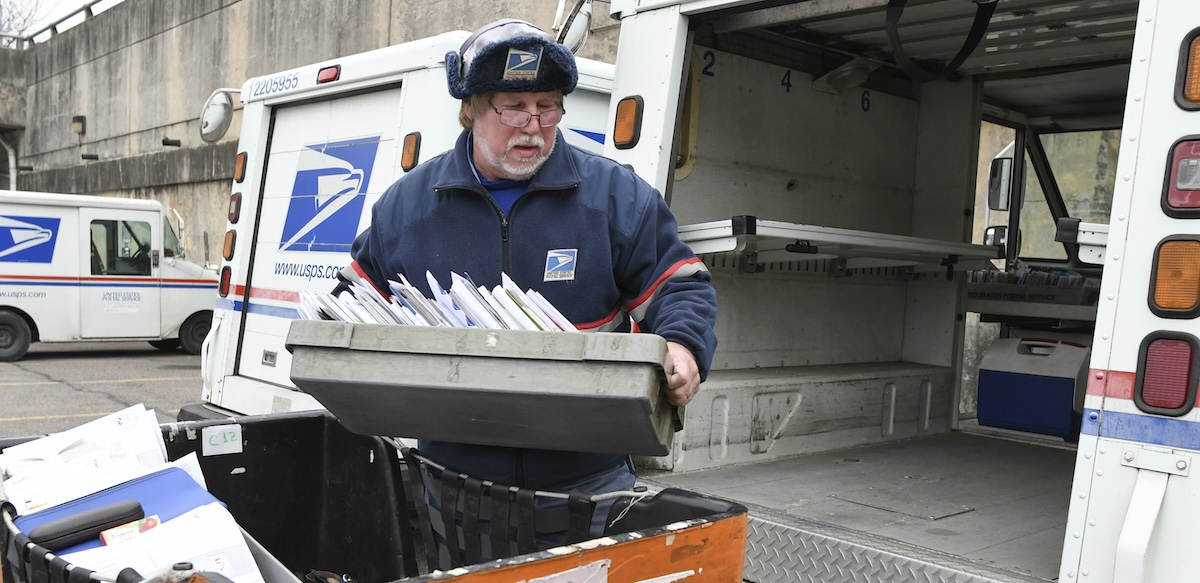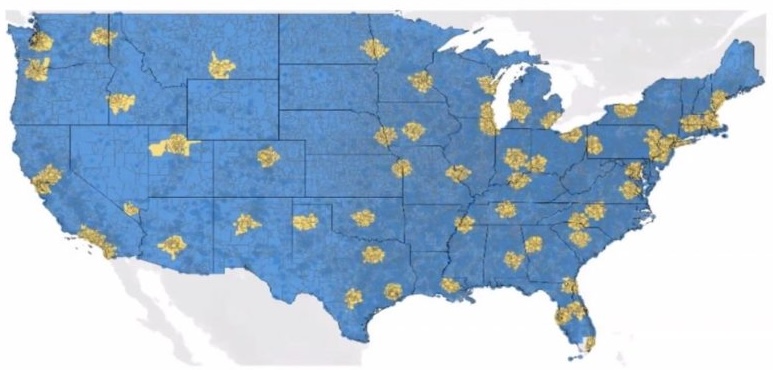Consolidation Threatens to Rip ‘Service’ Out of Postal Service

Letter carrier Greg Andregic loaded his truck for the day in downtown Pottsville, Pennsylvania, last year. Under postal consolidation, many letter carriers will face drastically longer commutes. Photo: Jacqueline Dormer/Republican-Herald via AP.
Workers are battling an overhaul of the U.S. Postal Service that would cost thousands of jobs and slow the mail for half the country.
In the name of efficiency, a letter mailed within Cheyenne, Wyoming, would travel to Denver and back. And if you miss a package, your local post office would no longer have it. It might be 45 minutes away.
In March, Buffalo became the first place to fend off the closure of its mail processing plant, in a team effort by Letter Carriers (NALC) Branch 3 and Postal Workers (APWU) Local 374.
The unions turned out 300 people to picket in front of the plant, and 700 to pack a public hearing, said Branch 3 President David Grosskopf. They deluged USPS with feedback in its online survey.
They lined up the support of their state reps and city council; they got neighboring town councils to pass resolutions too. They even got their senator to call the Postmaster General personally—and it didn’t hurt that their senator was Majority Leader Chuck Schumer. Within a few weeks, the plant consolidation was canceled.
ROBOTIC MEGA-PLANTS
Postal workers are the nation’s biggest union workforce—585,000 strong, split across four unions. They’re half women, 30 percent Black, and 16 percent veterans.
Thousands of their jobs are at stake under Postmaster General Louis Dejoy’s 10-year “Delivering for America” modernization plan, which would close 200 mail processing plants and funnel all mail to 60 mega-plants called Regional Processing and Distribution Centers (RPDCs), each with a football-field-sized parcel sorting machine—a series of conveyor belts, scanners, and chutes that can sort 5,000 packages an hour.
USPS is chasing its competitors Amazon, UPS, and FedEx, which already have bigger and more automated facilities like the UPS Worldport hub in Louisville, Kentucky, the size of 90 football fields, where a package touches human hands only twice—on its way in, and on its way out—traversing 13 minutes of conveyor belts in between.
The Buffalo mail plant would have been downgraded to a Local Processing Center, handling only incoming letters and flat mail. APWU and Mail Handlers (NPMHU) members no longer needed in the pared-down plant wouldn’t technically be laid off, but “excessed”: Of course there’s still a job for you, 75 miles away at the new mega-plant in Rochester! That’s how USPS gets around contractual anti-layoff protections, knowing many workers won’t uproot their lives.

Wyoming has only two mail plants, and both are slated to be downgraded, so all the mail (and many of the jobs) will travel out of state to the nearest RPDC. It used to be that local mail could get there overnight, said mail handler Ricci Roberts, president of the Cheyenne branch of NPMHU Local 321.
Now it will take at least two days, but more likely three or four, she says, as letters travel to Denver and back. There will be no way to separate local mail, because her plant will lose its AFCS machine—the one that sorts raw letters, cancels the stamp, and adds the barcode, all at a speed of 36,000 items an hour. They’ll keep their DBCS machine, which sorts incoming mail (at a similar clip) to get it ready for carriers to deliver.
The machines for sorting flats, such as magazines, are also being removed from plants around the country—so don’t be surprised if your copy of Labor Notes arrives later than ever.
DISASTROUS CHANGES
The first RPDCs have already opened, with disastrous results. Machines malfunctioned; the plants were seriously understaffed; the schedule was chaos; managers had no idea what they were doing. Mail piled up, and on-time delivery rates plummeted.
Local news outlets and Congressmembers sounded the alarm on mail delays. In Richmond, Virginia, colon cancer screening tests for 870 veterans sat so long in the plant that they expired. A museum reported it was missing $300,000 in membership renewal checks.
In Atlanta, trucks waited three or four hours for their turn at jammed loading docks; the line got so long it backed up onto the highway. In Houston, an anonymous worker tipped off the press that the new sorting machine wouldn’t fit in the new building.
USPS says these are just growing pains. But it has had to slow down, faced with protests and Congressional pressure—especially over how mail delays could affect the election. In May, DeJoy announced he would pause any further plant consolidations until the new year. In September, USPS canceled the downgrading of another eight plants besides Buffalo.
A PUBLIC TREASURE
Postal Service competitors are all in the package sector. There’s nobody else delivering birthday cards and pension checks—because this is a public service, not a money-maker.
True, you can send a document by UPS or FedEx, but it’s going to cost you dollars, not cents, and even more for a remote or rural address. Only USPS has a mandate to provide universal service at universal rates. Only USPS visits every doorstep, every day.
Demand for this service has declined in our era of email and electronic payments—but it’s still significant. Last year USPS carried 59 billion pieces of first class mail, 3 billion periodicals, and 7 billion packages.

SUPPORT LABOR NOTES
BECOME A MONTHLY DONOR
Give $10 a month or more and get our "Fight the Boss, Build the Union" T-shirt.
USPS is also still the biggest package shipper, though probably not for long. Last year Amazon leapfrogged UPS, and it is close on the Postal Service’s heels.
Muddying those figures is the fact that USPS actually completes the “last mile” of delivery for a substantial share of Amazon and UPS packages. Even as Amazon expands its subcontracted, nonunion delivery force, it’s likely to keep leaning on USPS wherever deliveries are too far-flung and labor-intensive to be profitable.
Competition from USPS also keeps a lid on the rates that UPS and FedEx can get away with.
HUBS AND SPOKES
Under DeJoy’s plan, some of the downgraded plants would also house Sorting and Delivery Centers (S&DCs), another new type of facility: home base for letter carriers from five to 10 zip codes.
Till now, letter carriers have always reported directly to the post office in their zip code. Many work at their own neighborhood post office, Grosskopf said, where they enjoy the benefits of a short commute and know they can make it to work in any weather.
“You gotta remember, this is Western New York,” he said. “We get this little thing called snow every now and then.”
There are 31,000 post offices in this country—one per zip code—more than there are Starbucks and McDonald’s locations put together. Think of post offices as a web: 99 percent of us have one within 10 miles of home. The new setup would be Amazon-style hubs and spokes.
Many carriers would commute 30-45 minutes to pick up the mail from an S&DC, then drive straight back to their delivery neighborhood in a rickety USPS delivery truck—and reverse those steps again at the end of the day.
ANTI-RURAL DISCRIMINATION
Another prong of DeJoy’s plan, “Regional Transportation Optimization,” will eliminate end-of-day mail pickup from post offices farther than 50 miles from an RPDC—which is three-quarters of all post offices, covering half the population—adding another day to delivery times.
“He wants to have full trucks only,” Roberts said. “From a rural lens, looking at it here in Wyoming, we never get full trucks. We don’t have the population to sustain that. So the only way to do that is to delay the mail.”
A map (at right) released in September shows the areas where service will be slowed, a dark sea—punctuated by a few dozen light spots around the RPDCs, where it will supposedly improve. Delivery gets worse in every rural area as well as some major cities, like Columbus and New Orleans, that would have their mail plants downgraded.
“It’s discrimination against the rural communities, without coming out and saying it,” Roberts said.
PIECEMEAL PRIVATIZATION
What’s behind all the attacks on the postal service? Unlike other public services that are perennially on the chopping block, USPS already gets zero tax dollars.
Yet a string of right-wing politicians, Donald Trump among them, have called for privatizing it. Some European countries have actually done that, to the detriment of customers and workers. The U.K., for instance, privatized the Royal Mail a decade ago; now its parent company plans to resell it to a Czech billionaire.
So far the U.S. public seems unwilling to stomach wholesale postal privatization. But piecemeal privatization started long ago, and the low-hanging fruit have already been picked.
Eighty to 90 percent of letter mail is presorted by private companies, who get a hefty postage discount for taking away union postal work. USPS also contracts out a lot of trucking—some of it to DeJoy’s old company, XPO Logistics.
Steve Hutkins, a retired English professor who runs the excellent blog savethepostoffice.com, sees USPS undergoing a “gradual process of corporatization,” so that it is run more with the values of a profit-making business rather than a public service.
Service cuts, he has observed, generally end up saving less money than anticipated. “Most things that save money involve cutting services,” he said. “There’s no magic to just being more efficient.” And when you slow down the mail, some dissatisfied customers go elsewhere—so you lose revenue, eating into any cost savings.
A BETTER WAY
Interestingly, this summer DeJoy moved to eliminate some of the presorting discounts for package consolidators. Perhaps this simply makes business sense now that USPS can do the work more cheaply in-house, by replacing workers with machines.
Still, in a press release, APWU President Mark Dimondstein called it “a welcome early step in the right direction” to undo rampant outsourcing.
Postal unionists have their own vision for modernizing USPS: rather than cutting costs, raising revenue by expanding services. Since letter carriers are already visiting every door, why not offer an option where they check in on elderly residents?
Since post offices are already in every community, why not make them hubs for internet access, fishing licenses, passport renewals, electric vehicle charging, and even basic banking as an alternative to predatory check-cashing stands?
“If I were running the Postal Service, I wouldn’t want trying to save money to be my top consideration,” Hutkins said. “If the emphasis were on improving service rather than cutting costs, you could start talking about what else can the Postal Service do. Jobs are a good thing; they’re good for the community. I wouldn’t look to be replacing jobs with machines.”






